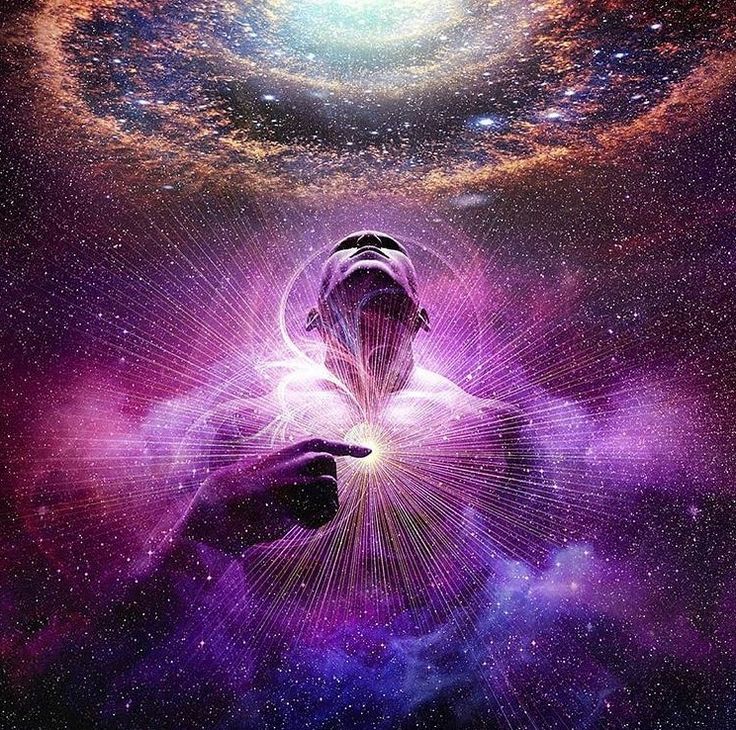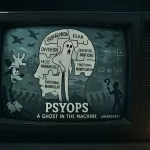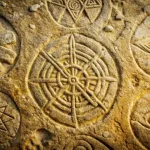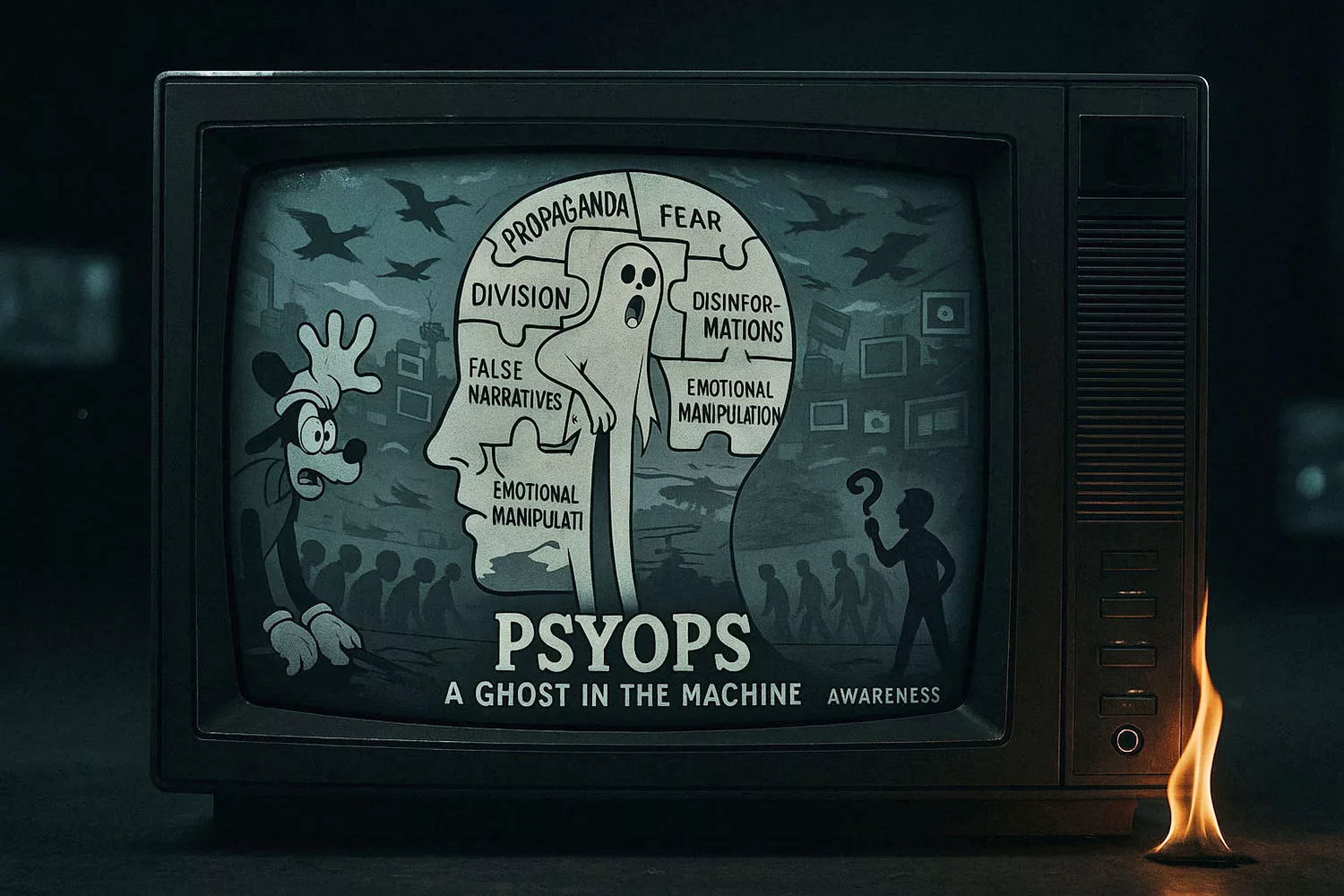
by David Hatcher Childress
July 23, 2023
from AncientOriginsUnleashed Website
| David Hatcher Childress, is a captivating speaker and the author or coauthor of over 20 books. He is the founder of the World Explorer’s Club. |
by N.Roerich (1929)
(Public Domain)
In the 19th century a Hindu priest introduced British army Colonel James Churchward to ancient tablets, revealing the existence of a primordial lost civilization,
which led to Churchward’s lifetime quest, spanning several continents and islands, to unravel the
mysteries of Mu, a Pacific continent, which was destroyed in a cataclysmic shift of the earth’s poles.
He discovered remnants and relics of this 200,000-year old civilization, and considered the great civilizations of Atlantis and the old Oriental empires, India, Egypt and Babylonia, as the ‘offspring’ or dying embers of Mu…
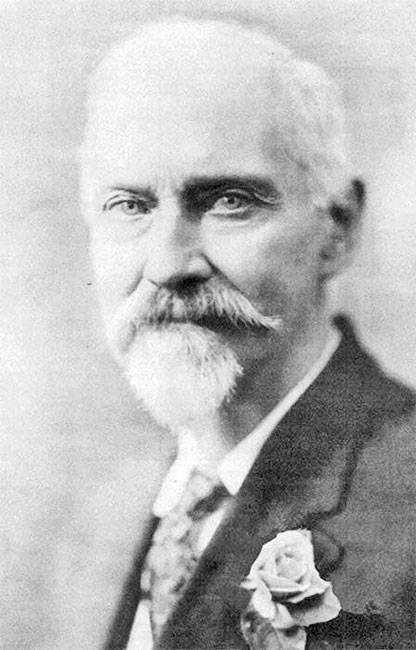
Colonel James Churchward
(Public Domain)
James Churchward Meets The Rishi
Colonel James Churchward was born in Devonshire (southern England) in 1851.
The Churchwards were an old Devonshire family with a strong Masonic background. He told friends that he had been educated at Oxford and the military academy at Sandhurst.
In 1868, at only 18 years of age, he was sent to India as a young military officer. As part of the British military in occupied India, Churchward eventually rose to the rank of Colonel.
His first assignment brought him to Central India to assist in famine relief, and it was here that he made a contact that would change his life.
A high-ranking Hindu priest, known as a rishi from a temple school monastery befriended him, and a 12-year association began. As the friendship deepened, the rishi gave Churchward access to some very rare and mystical ancient tablets which had purportedly been hidden in the temple vaults for thousands of years.
The tablets were carved with arcane symbols, and the rishi began teaching Churchward how to interpret some of the simpler signs.
Churchward proved an avid student, and the lessons continued until eventually Churchward had mastered the language – supposed to be the original language of mankind…!
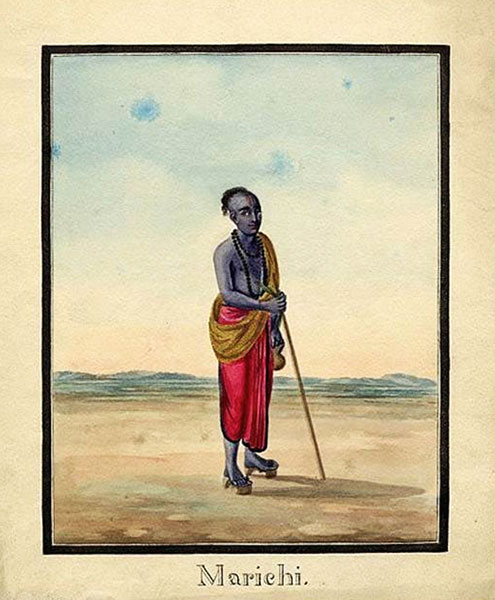
19th- Century Marichi,
a Rishi and son of Brahma.
(Public Domain)
The tablets revealed facts about the origin of civilization, and the tales they told of an advanced worldwide culture that disappeared after cataclysmic earth changes in the far distant past would “fire the dullest imagination.”
After 12 years of studying Mu (as this mother civilization was known) with the rishi, Churchward felt it was time to leave India.
His knowledge of the primordial civilization described on the tablets of the temple, combined with a scholar-adventurer’s curiosity and wanderlust, spurred him to search for further evidence of this civilization.
Following the Trail From Asia To Egypt
About 1880, the Colonel retired from the British military and left India for the South Seas (specifically, Tonga and the Caroline Islands).
Here, Churchward found evidence for the existence of Mu in the form of rock carvings, which he deciphered using the language of Mu.
These carvings, which he believed were being read correctly for the first time since the fall of Mu, prompted him to continue his search in Tibet and parts of Central Asia.
One would imagine that Churchward used his status and contacts as a retired Colonel to travel relatively cheaply with military convoys, sleeping in army barracks and such.
His letters of introduction from other British officers would no doubt serve him well.
Travel in the late 1800s and early 1900s was expensive and slow, especially in Central Asia and the vast Pacific; even today many Pacific Islands are difficult and expensive to reach.
Churchward became an extremely well-traveled man for the time period, by any standard.
Facade of the Egyptian Museum,
Tahrir Square, Cairo
(Diego Delso/ CC BY-SA 3.0)
From Tibet, Central Asia and India, Churchward journeyed to Egypt where he explored the pyramids and visited the Bulaq Museum in the ancient city of Cairo (now the Cairo Museum of Egyptian Antiquities, Egypt’s main museum).
Churchward examined Egyptian hieroglyphs and papyrii in light of the symbol-language of Mu and attempted to translate some of the documents in terms of that arcane language taught to him by the rishi.
Evidence of The Pole Shift
About 1885, Churchward found his way to Siberia and the valley of the Lena River.
He was now looking for evidence of ancient cataclysms, which, if it could be found, would lend credence to the idea that an ancient, advanced civilization such as Mu could disappear.
Churchward wanted to see the piles of mammoth bones and tusks washed up in tidal waves on the Lackoff Islands (The Islands of Bones) just beyond the mouth of the Lena.
He was convinced by these giant piles of ivory and bones that a ‘pole shift‘ phenomenon had occurred in the past, where the earth’s crust slipped several degrees toward the equator causing massive tidal waves to wash over portions of the earth and ultimately cause the sinking of entire continents such as Mu.
(Author provided with permission © Children of Mu)
From Siberia he made his way toward the Ural Mountains and what he called “the end of the Drift Line.”
Here his trail in search of the cataclysms of the past ended, and Churchward felt he had the geological and historical proof that he needed to establish the existence of ancient civilizations.
Churchward had been told by the rishi that,
an ancient civilization contemporaneous with Mu had existed in the Gobi Desert,
…and found evidence in the region to make him believe this was true.
The local tradition of the land of Shambala (or Agartha) told that it was the remnant of an advanced ancient civilization that was also destroyed in the cataclysmic pole shift, with its attendant earthquakes, tidal waves and volcanic activity.
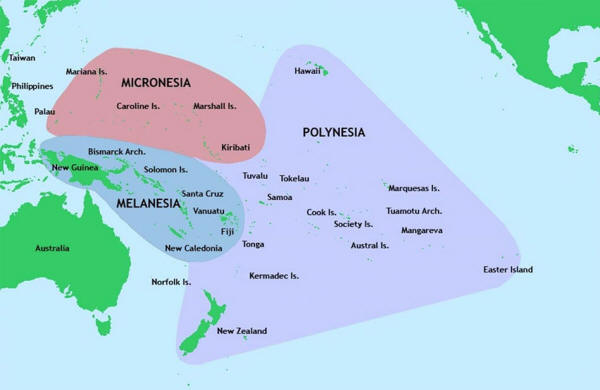
Map Pacific Islands Region.
(Public Domain)
Australasia and The South Pacific Islands
Churchward then went to Australia where he worked for some years.
Urged by relatives to visit New Zealand, Churchward there gathered some information from local Maoris that again sent him traveling for further evidence of Mu.
He journeyed as a passenger on assorted tramp steamers going to various Polynesian Islands in the South Pacific.
For over two years he explored numerous islands and island groups, including Samoa, Tahiti, the Marquesas, Tonga, the Gilbert Islands, the Cook Islands, Easter Island, Hawaii and others.
Churchward believed the megalithic remains he found throughout the region, coupled with island legends of sunken continents, were the final evidence he needed to write his book on the ancient, sunken continent of Mu.
He believed that he had at last substantiated the stories he had learned through his studies with the rishi.
Says Churchward:
“That story is the story of Mu and her vast civilization which spread over the whole world 20,000 to 200,000 years ago, inclusive.
It is the story, not only of how that civilization grew, but of how it was destroyed and lapsed into the savagery out of which our own modern culture has developed….”
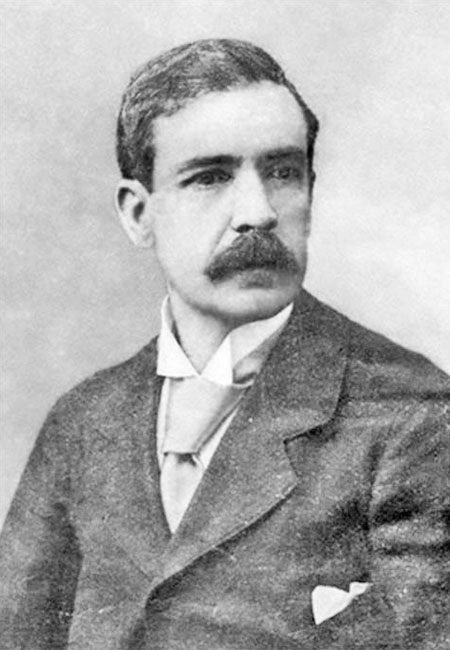
William Niven (1850-1937),
mineralogist and archaeologist (circa 1895)
(Public Domain).
Niven’s Tablets Of Mexico
So, James Churchward, with his extensive documentation, including photographs, personal paintings and proofs, came to America, where he settled in New York by 1888.
He soon met Percy Tate Griffith, who was to become his best friend in his later years.
Churchward lived in New York until his death in 1936, with the exception of two years when he joined his friend William Niven in Mexico and Central America.
Niven’s discoveries of ancient buried cities in the valley of Mexico were exciting to Churchward and he joined Niven in Mexico City and traveled to the Yucatan and other areas of Central America to compare the records discovered there with those he had found the world over.
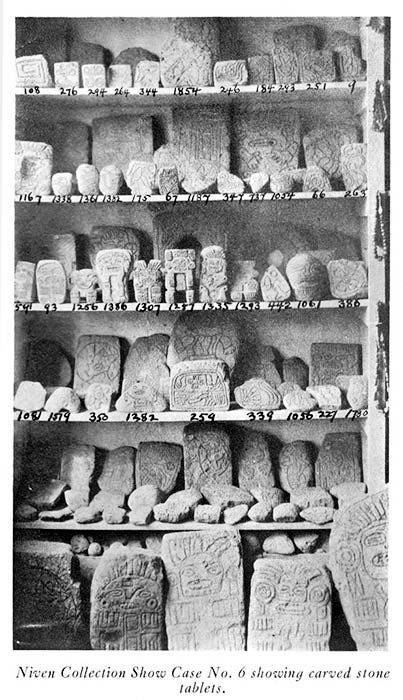
Niven’s Collection of Mesoamerican stone tablets
(Author provided with permission © Children of Mu)
Back in New York, Percy Tate Griffith would sit in the evenings with Churchward, and they were often joined by Augustus and Alice LePlongeon.
Augustus LePlongeon was a dedicated French Mason and had done much of the early excavations at Chichen Itza in the Yucatan.
His book Queen Moo and the Egyptian Sphinx was published in 1900 in London and was popular among archaeologists and mystics of the time.
Churchward, Griffith and the LePlongeons would sit in Churchward’s or Griffith’s study for hours talking about Atlantis, Mexico, Tiahuanaco and Churchward’s belief in his sunken continent of Mu.
The Lost Continent Of Mu
By the early 1920s and Churchward in his old age began to tell his friends of the Golden Age that had existed thousands of years ago on the sunken continent of Mu.
This culminated in the self-publishing in 1926 of The Lost Continent of MU.
Churchward’s book made quite a splash at the time. It received wide attention from reviewers and became the subject of much discussion.
Indeed, such groups as the Rosicrucians (AMORC) and the Lemurian Fellowship took Churchward’s books to heart and sought to elaborate on his works, with which they were largely in agreement.
showing how he thought Mu refugees
spread out after the cataclysm
through South America,
along the shores of Atlantis,
and into Africa.
(Public Domain)
Churchward was a very good artist and filled his books with his own maps and paintings, as well as photographs he had collected in his travels.
He had sketched the megalithic arch in Tonga back in 1876, probably before he ever thought he would write a book.
He cut a publishing deal with the New York City publisher Ives Washburn (now defunct) for the republishing of his book, plus the publishing of his follow-up books.
‘The Children of Mu’ and ‘The Sacred Symbols of Mu‘ came in quick succession.
Said the cover blurb for The Children of Mu, a book largely about the colonization of Atlantis and the rest of the world:
“When Mu, the now-lost Pacific continent, became overcrowded, colonization began… and America was one of Mu’s first colonies.
From America to Atlantis to Europe and Africa the movement of colonization continued, until cataclysms destroyed Mu and Atlantis.”
The cover copy for The Sacred Symbols of Mu reads:
“James Churchward continues his occult and historical explorations of the world’s most fabled lost civilization – Mu, the motherland of mankind.
Stressing the common origin of all contemporary religions, Churchward’s highly unorthodox, startling theories about the ‘Sacred Inspired Writings of Mu’ suggest that this ancient text was the basis of Christianity itself!
No student of the occult, comparative religion or anthropology can afford to miss the excitement.”
(Adventures Unlimited Press)
Churchward was a popular media figure for a few short years, and in 1934 and 1935 his final books were published.
The cover copy on The Cosmic Forces of Mu, Volume One reads:
“The Cosmic Forces of Mu were understood perfectly as recently as 15,000 years ago.
Their application brought this lost civilization to extraordinary peaks of technology – accomplishments we are only now beginning to understand and achieve.
Working from ancient tablets, James Churchward has recreated this astounding science.
Everyone fascinated by prehistoric times and the occult will be gripped by The Cosmic Forces of Mu.”
The cover copy on The Cosmic Forces of Mu, Volume Two reads:
“In this fifth book in his amazing Mu series, James Churchward challenges many of the theories and ‘knowledge’ of modern science with a startling new interpretation of the birth of earth based on the ancient wisdom of the lost civilization of Mu.
That there was no such period as the Ice Age – and he tells what happened and why. That the center of the earth is not molten lava but gas.
That Man in his present form lived through all the cataclysmic changes of the earth – and he gives archaeological proof of it.”
Colonel James Churchward died approximately one year after the publication of his final book.
He died satisfied that the lessons of the rishi had filled the void that had come in his life after leaving India, and the world had now heard the rishi’s message.
Moʻai facing inland at Ahu Tongariki,
on Easter Island restored by
Chilean archaeologist Claudio Cristino
in the 1990s.
(CC BY-SA 2.5)
Excerpt From: The Children Of Mu – The Origin of Man
The Land of Mu was a large continent situated in the Pacific Ocean between America and Asia, its center lying somewhat south of the equator.
Basing its area on the remains which are still above water, it would have been about 6,000 miles from east to west, and about 3,000 from north to south. All the rocky islands, individually and in groups, scattered over the Pacific Ocean were once part of the continent of Mu.
About 12,000 years ago cataclysmic earthquakes rent Mu asunder. She became a fiery vortex, and the waters of the Pacific rushed in, making a watery grave for a vast civilization and 60-million people.
Easter Island, Tahiti, Samoas, Cook, Tongas, Marshall, Gilbert, Caroline, Marianas, Hawaii and the Marquesas are the pathetic fingers of that great land, standing today as sentinels to a silent grave.
(Author provided with permission © Children of Mu)
The existence of this great continent is confirmed by:
- Naacal tablets, books, writings, inscriptions and legends found in India, China, Burma, Tibet and Cambodia
- ancient Maya books, inscriptions, symbols and legends found in Yucatan and Central America
- remains, inscriptions, symbols and legends found among the Pacific Islands
- stone tablets found in Mexico near Mexico City
- cliff dwellers’ writings and inscriptions found in Western North America
- books of old Greek philosophers
- books and writings of the ancient Egyptians,
…and legends throughout the world.
(Author provided with permission ©Children of Mu)
These confirmations are all given in The Lost Continent of Mu.
They show that there was once a large continent of land in the Pacific Ocean called the Land of Mu. On this great continent man made his advent on earth about 200,000 years ago.
The Land of Mu and the Biblical Garden of Eden were one and the same land. Both the Naacal and the Mexican tablets show clearly that man is a special creation.
They also show in what way he differs from all other creations. An account of the creation is given in both sets of tablets which is very similar to the Biblical account.
At the time of Mu’s destruction her people were in an exceedingly high state of civilization; as regards science she was far ahead of the present time.
No wonder! She was at the end of 200,000 years of experience and development.
The great civilizations of the old Oriental empires – India, Egypt, Babylonia, etc. – were only the dying embers of Mu’s great civilization. They were her children, who withered and died without her care.
All tablets, inscriptions and writings which I used in The Lost Continent of Mu are accompanied by keys for reading them.
Every assertion made is accompanied by reasonable proof. The facts are there. The theories will have to take care of themselves. I wish it understood that what is revealed of the past in my writings must not be considered discoveries by me.
I am simply stating what I find in writings that run from 12,000 to 70,000 years ago if the mode of keeping time was correct.
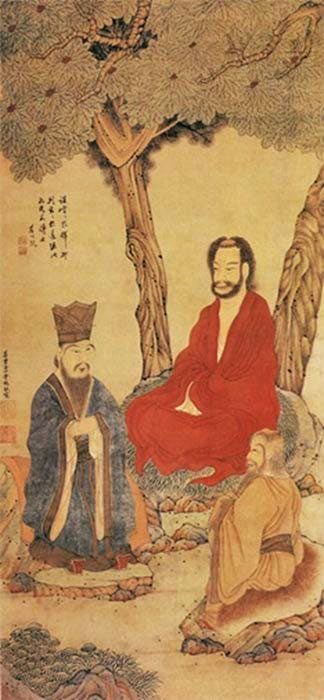
Confucius meets Lao-tzu and Buddhist Arhat
(Ming Dynasty) Palace Museum, Beijing.
(Public Domain)
What is disclosed in these writings is startling, yet archaeology and geological phenomena corroborate the facts without calling to our aid legends which also confirm them.
Lao Tsu, the Chinese sage of 600 BC, speaks of the great learning and advancement of his prehistoric forefathers.
The ancients were wise and thoughtful for those who were to come after them. They left indestructible records written on clay and stone. This wisdom is spoken of by Souchis priests of Sais to Solon the Greek, as recorded in Plutarch.
These writings have been broken up and many of them lost. As they were universal among the ancients, scraps and fragments of them are found in all quarters of the earth.
When put together they supplement one another to a great extent, so that by combining them we can make a beginning towards unraveling the wonders of the earth’s First Great Civilization.
For over 50 years I have been hunting these scraps and putting them together so as to form the beginning of an intelligent tale of the Creation and Man.
It rests with those who come after me to complete the tale.
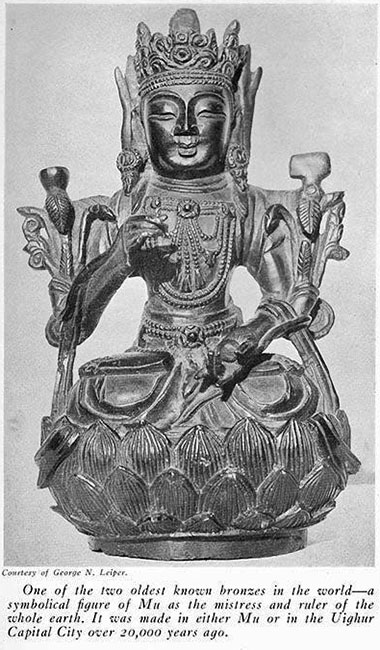
Sculpture of Mu as the mistress of the whole earth.
(Author provided with permission © Children of Mu)
Ancient relics, that can be traced back as coming directly from Mu, the Motherland, are extremely rare.
During the past few years, I have been singularly fortunate in finding two that are at least intimately connected with Mu. Both are symbolic figures in bronze.
They were either made in the Motherland or in one of the ancient Uighur cities before the eastern half of that great empire was destroyed by the north running wave of the last magnetic cataclysm which was the ‘Biblical Flood’.
This wave destroyed all the country over which it ran, the people were drowned and the cities washed away or buried under the drift. The Uighur capital city today lies under 50 feet of boulders, gravel and sand.
It is situated in the Gobi Desert, which today has large areas of rock only, the soil and everything with it having been washed away by the ‘Flood’.
I am using one of these relics as the frontispiece of this book. It is, without question, one of the two oldest bronzes in existence. If Uighur, it is about 18,000 or 20,000 years old.
If from Mu, the age cannot be estimated.
This figure is a symbol of Mu as the great ruler. The fineness of the workmanship is not to be found surpassed, and very seldom equaled in any of the prominent jewelry stores in our big cities today.
Both symbols have been in America for about 150 years.
I know their history, but the less said about it the better since, in the Oriental home from which they were taken, they were without question sacred relics.
The British Museum has three scepters which undoubtedly were manufactured in Mu before she went down.
by Francis Danby (1840)
(Public Domain)
In Mu, the Motherland, there were ten distinct tribes.
Although they were physically easily differentiated, there were few variations in language, and these only of a minor character. A greater change is seen in their glyphs or writings.
In the Motherland each of her people occupied its own territory; and, when various tribes took part in the colonization of a new country, they did not settle down indiscriminately, but each tribe took its own land and built its own cities as their fathers did in Mu.
They settled down adjoining each other and formed a homogeneous whole.
Every letter in every word in the ancient language of Mu is pronounced.
- Mu is pronounced Moo
- A is pronounced ah
- U is pronounced oo as in moon
- Ta is pronounced tah
- Tau is pronounced ta-oo
This original form of isolation grew with time so that the tribes eventually became separate peoples, and finally nations.
And as the isolation became greater, changes in language crept in.
Adieu Professional Traveler
James Churchward was a fascinating man, and truly a man for all seasons.
He was a military man and administrator, a mystic and student of ancient languages, an artist and mapmaker, as well as a calligrapher. He was also a salesman, an inventor and author.
For many years he was that rarest of breed, ‘the professional traveler’.

| There are many theories about a land called Lemuria, Pacifica, or Mu. Most of what is written about Lemuria is metaphoric – linking to the patterns of creation and sacred geometry. It is about spiraling consciousness that moves from higher frequencies of thought – a higher harmonic – to slower – lower frequencies as we experiencing many places at the same time. |  |
As with Atlantis – one has to wonder if Lemuria ever existed in the physical realm – or is it just a metaphor – to remind us that out souls are experiencing multidimensionally – some of which we believe are other planet experiences.
As is Above, so is Below – ALL being polarity of experience. As we have the Atlantis in the Atlantic region – we must have its Pacific counterpart – Pacifica. All realities are created based on the digits of sacred geometry – the blueprint of all we experience.
As an opinion – Lemuria is a grid program that exists parallel to our own. Those who feel linked to it – are more-than-likely experiencing in both realities simultaneously.
In truth – Lemuria – from our perspective in third dimension – is theoretical and will not merge with us – until a point at which we expand our consciousness to fully understand all of our multi-dimensional experiences. We are moving to that end now. Stone markers are found in our reality – to remind of of ancient and lost civilizations – in which we coexist. In the end – we awakening to our true nature. The hermetic seals of consciousness, so to speak, are opened with a bang – the ‘end time scenario’ of an explosive ending. We instantly spiral consciousness back to greater understanding of all.
Many see this as the movement into a Golden Age – the gold being a metaphor for Alchemy of consciousness into awareness – the blue and the gold – the blueprint and the alchemy. When we see ourselves back as the Lemurians – we are seeing ourselves in higher frequency. One must not forget that time is an illusion that brings depth to physical experience.
All happens at the same time.

 Symbolic drawing made in 1931 by Mayan glyph researcher, James Churchward, depicting a cataclysm of earthquakes and volcanoes that allegedly sank the continent of Mu in the Pacific Ocean. Symbolic drawing made in 1931 by Mayan glyph researcher, James Churchward, depicting a cataclysm of earthquakes and volcanoes that allegedly sank the continent of Mu in the Pacific Ocean. |  Churchward’s map showing how he thought Mu refugees spread out after the cataclysm through South America, along the shores of Atlantis and into Africa. Churchward’s map showing how he thought Mu refugees spread out after the cataclysm through South America, along the shores of Atlantis and into Africa. |
James Churchward, in books such as The Lost Continent of Mu (1931), wrote that the Motherland stretched from the Hawaiian Islands to Fiji and from Easter Island to the Marianas. Churchward considered the Nan Modal site on Pohnpei Island one of the seven sacred cities of Mu. Today its ruins sit on a swampy lagoon filled with mangrove trees. Rising about 30 feet in height, black volcanic stones weighing many tons are stacked crisscross like a child’s frontier fort.
It’s one of the more enigmatic sites in the entire Pacific, yet archaeologists cannot explain how it got there.
Indeed, stone monuments of mysterious origin dot the entire Pacific, from Japan’s spectacular underwater site at Yonaguni to cryptic Petroglyphs on Hawaii’s Big Island. Menehune Ditch on Kauai is built from dressed and fitted stone slabs like something ancient Romans would have erected, very different from typical Polynesian style. And of course there is Easter Island, centerpiece of many Lemuria theories. Its hundreds of colossal stone statues and written language point to an advanced culture, yet it appeared on the world’s most remote spot. Why?
The legends of Easter Island speak of Hiva, which sank beneath the waves as people fled, while Samoans called a similar place Bolutu. It was stocked with trees and plants bearing fruits and flowers, which were immediately replaced when picked. On Bolutu men could walk through trees, houses, and other physical objects without any resistance. The Maoris of New Zealand still talk about arriving long ago from a sinking island called Hawaiki, a vast and mountainous place on the other side of the water.
There’s yet another puzzling piece of evidence. A map of the lost continent published by the Lemurian Fellowship corresponds almost exactly to boundaries of the Pacific Plate. But the map first appeared long before geologists even knew of the plate’s existence.
Their detailed map places the capital just north of present day Maui, near the center of a vast continent stretching from Australia to the Rocky Mountains!
2.- Tony Earll
In the 1970s Tony Earll‘s Mu Revealed (one of countless books written about the sunken civilizations Atlantis, Mu and Lemuria) claimed to be “an astonishing account of the archaeological discovery that proves the existence of Mu“.
From the cover:
“When the Hurdlop expedition began excavating, it was with the hope of proving or disproving James Churchward’s startling theories about Mu, the ancient lost continent of the Pacific…What they found was beyond their wildest expectation — the diary of Kland, a young priest who had emigrated from Mu before its destruction! Painstakingly restored and translated, the diary scrolls provide breathtaking glimpses into the everyday life of Mu at the height of its splendid, doomed culture.”
3.- David Childress
According to David Childress various esoteric sources, the first civilization arose 78,000 years ago on the giant continent known as Mu or Lemuria and lasted for an astonishing 52,000 years. It is sometimes said to have been destroyed in earthquakes generated by a pole shift which occurred some 26,000 years ago, or at approximately 24,000 B.C.
While Mu did not reach as high a technology, supposedly, as other later civilizations, it is, nevertheless, said to have attained some advanced technology, particularly in the building of long-lasting megalithic buildings that were able to withstand earthquakes. However, it was the science of government that is sometimes said to have been Mu‘s greatest achievement.
Supposedly, there was one language and one government. Education was the keynote of the Empire’s success, and because every citizen was versed in the laws of the universe and was given thorough training in a profession or trade, magnificent prosperity resulted. A child’s education was compulsory to the age of 21 in order for him to be eligible to attend citizenship school. This training period lasted for seven years; so the earliest age at which a person could become a citizen of the empire was 28. Earthquake-resistant walls were important all around the Ring-of-Fire, in ancient Mu.
It is claimed that the Elders of Lemuria, known as the Thirteenth School, moved their headquarters prior to the cataclysm to the uninhabited plateau of Central Asia that we now call Tibet. Here they supposedly established a library and school known as ‘The Great White Brotherhood’.
4.- Helena Petrovna Blavatzky
In her book The Secret Doctrine (1888), Madame Blavatsky claimed to have learned of Lemuria in The Book of Dzyan – which she said was composed in Atlantis and shown to her by the Mahatmas. However, in her writings she gave Philip Schlater the honor of inventing the name, Lemuria.
Blavatsky located her Lemuria in the Indian Ocean about 150 million years ago. She may have obtained her ideas of a sunken land in the Indian Ocean from Sanskrit legends of the former continent of Rutas that sank beneath the sea. But the name Rutas sounds too spiritless and uninspiring to have held such a prominent place in cosmic history.
Blavatsky placed her “Third Continent of the Third Root Race” in the Indian Ocean between Madagascar and Malaysia. Surprisingly, many scientists of her day concurred and even came up with the name, derived from ‘lemur’, the ghostlike primates who supposedly lived there. Blavatsky described the Lemurians as “the third root race” to inhabit the Earth. They were egg-laying beings with a third eye that gave them psychic powers and allowed them to function without a brain.
Originally they were bisexual – their downfall came about after they discovered sex.
[These are metaphors for male and female – polarities and moving from beings of light who have no sexual orientation as they do not exist in the electromagnetic energies of a physical body.]
5.- The Rig Veda
The myths and traditions of India abound with references. The Rig Veda in particular speaks of “the three continents that were”; the third was home to a race called the Danavas. A land called Rutas was an immense continent far to the east of India and home to a race of sun-worshippers. But Rutas was torn asunder by a volcanic upheaval and sent to the ocean depths. Fragments remained as Indonesia and the Pacific islands, and a few survivors reached India, where they became the elite Brahman caste.
6.- Rudolf Steiner
The Austrian mystic Rudolf Steiner claimed that during the sixth and seventh subraces (of the Third Root Race) colonies were established as far away as Easter Island. The continent girdled much of the Pacific near the Equator, and thousands of island peaks remain to mark its former glory.
7.- Edgar Cayce
Edgar Caycemade a distinction between Mu, which floated off the coast of Baja California, and Lemuria, whose location is confusing to say the least. According to Cayce: “The Andean, or the Pacific coast of South America, occupied then the extreme western portion of Lemuria.” Either he meant eastern, or Earth’s land masses have changed a lot, perhaps due to a pole shift or crustal slippage.
The channeled entity Seth spoke of a civilization called Lumania on the island of Maskara, whose mountain peaks today form Indonesia.

Both Blavatsky and Ruth Montgomery (The World Before) dated Lemuria to millions of years ago. Yet most sources define the Lemurian era as roughly 75,000 to 20,000 B.C., still prior to Atlantis. Some scholars believe the two civilizations co-existed for thousands of years.
 |
A handful of radical geologists (called Catastrophists) believe a continent called Pacifica existed within the last 100,000 years, and that its fairly rapid submersion caused mountains on the perimeter to rise and created hundreds of volcanoes called the Ring of Fire. Sea levels worldwide were disrupted as water rushed in to fill an enormous basin created by the sinking and caused oceans to drop hundreds of feet.
Lemuria‘s appearance with a full-blown culture has spawned many interesting theories, including visits from extraterrestrials who introduced a new species of genetically engineered humans to replace their dim-witted ancestors. (This might explain the reference in Genesis to the ‘sons of gods’ mating with the ‘daughters of men.’)
In any case there is no question humanity made a kind of great leap around 40,000 B.C. with advances in transportation, technology, art, and language. In Europe the Cro-Magnons, in the Pacific Lemurians.
What was Lemuria like?
Was it home to a gentle race of mystics and dreamers or an advanced society whose technology helped bring it down? According to Theosophy, Lemurians had pliable, jelly-like bodies and slowly developed physicality. The first Lemurian subraces were apelike, egg-laying hermaphrodites who communicated by mental telepathy through a ‘third eye.’ This atrophied after Lemuria‘s fall and became the pineal gland still found in modern humans. These androgynous beings lived in perpetual torpor like the Lemurian Dreamers that the channeled entity Lazaris speaks about.
Finally, the ever-increasing density of matter helped usher in an era of sexual reproduction, and two distinct sexes emerged from one being. This marked the fall of man, and henceforth male and female would strive to reunite as one body through sexual intercourse.
Yet most sources claim Lemurians were much more like modern humans, living in an idyllic paradise, largely agrarian with lush forests and an abundance of flowers and fruit trees. Feminine principles of sharing, cooperation, and creativity produced a society virtually free of crime, strife, and warfare. Lemurians were vegetarians and lived in harmony with nature and other creatures, and they had a highly developed psychic and telepathic senses, which were applied in practical endeavors such as horticulture. People believed in ‘mind over matter’ and were adept at manifestation and other ‘reality creating’ techniques. This tradition survives, some claim, in the Polynesian concept of mana and various fire-walking ceremonies throughout the region.
Even traditional anthropologists are puzzled by a pre-Polynesian culture that stretched across most of the Pacific. Widely separated locales displayed astonishing similarities in village life, religious cults, myths, and foods such as coconuts, bananas, and taro. Over time each area, such as Polynesia, grew more diverse and distinctive and eventually lost contact with the other.
The languages of this culture were thought to be Austronesian, which includes hundreds of related tongues still found today from Polynesia to distant Madagascar.
What happened to Lemuria?
Can an entire continent sink or vanish? That’s something most geologists say is impossible. Yet the event is widely supported by Pacific area mythology from Australia to Arizona.
From Hopi legend:
‘Down on the bottom of the seas lie all the proud cities, the flying patuwvotas, and the worldly treasures corrupted with evil…”
Faced with disaster, some people hid inside the earth while others escaped by crossing the ocean on reed rafts, using the islands as stepping-stones. The same story of escape to dry land appears in the Popul Vu epic of the Quiche Maya and the Modoc tribe near Mt. Shasta among many others.
According to the Rosicrucians of San Jose, California, the disastrous cycle began with volcanic eruptions, earthquakes, and collapse of subterranean gas belts. Magnetic waves started moving around the globe, and Lemuria began to go under. Fortunately, there was time enough for small groups to salvage part of Lemuria‘s precious wisdom, which was stored in crystals. Some colonists reached India and from there Mesopotamia and Egypt, while others migrated eastward on crude rafts to the Americas, forming the racial core of the earliest Indian tribes. In fact, California was home to history’s oldest people: pure Lemurians who later became the California Indians. That would explain why America’s oldest human artifacts were found on Santa Rosa Island off Santa Barbara, dated around 25,000 B.C.

